12 Health Benefits of Akarna Dhanurasana & How to Do It?
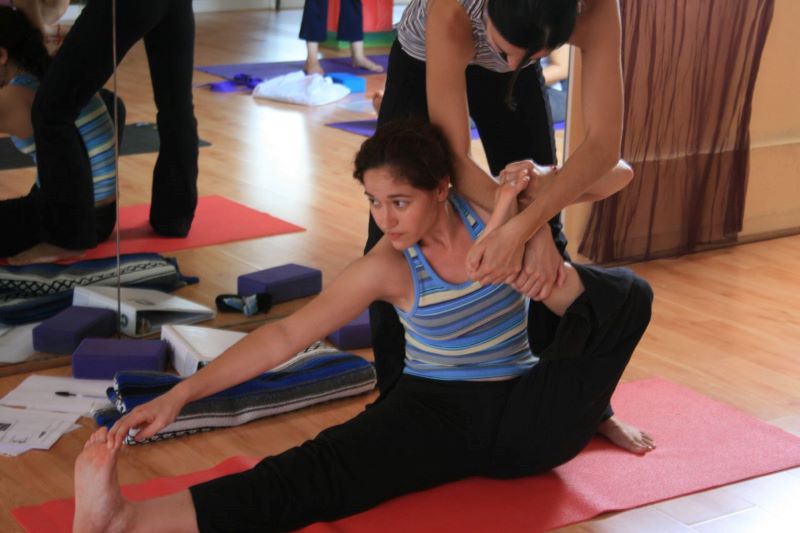
If you want to aim at boosting flexibility and strength altogether, yoga is one of the most effective and durable procedures. However, you need to practise advanced-level asanas to achieve your goals.
One yoga pose that can help you reach your targets and provide plenty of health benefits is the Archer's Pose or Akarna Dhanurasana. Those who want to include the Archer's Pose in their workout routine can read this write-up to know more.

Table of Contents

What is Akarna Dhanurasana (Archer's Pose)?
Akarna Dhanurasana is known as the Archer's Pose because it resembles the posture of an archer. The major benefits of practising this are working on your legs, toning your abs, and enhancing flexibility.
The intensity of this asana engages your entire body. As it includes extreme stretching, it is not recommended for beginners. Nevertheless, if any beginner wants to try practising this, they can start with preparatory poses to loosen muscle stiffness.
Here is a list of preparatory poses you can try before doing this yoga posture.
Supta Padangusthasana (Reclining Hand-to-Big-Toe Pose)
Malasana (Garland Pose)
ParipurnaNavasana (Boat Pose)
Ardha Navasana (Half Boat Pose)
Baddha Konasana (Bound Angle Pose)
How to Perform the Akarna Dhanurasana (Archer's Pose)?
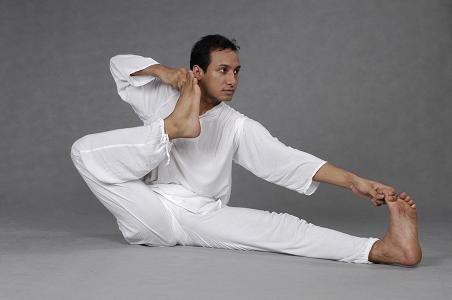
Since the Archer's Pose is an advanced level of yoga, you must learn the steps to perform this yoga accurately. Here is a step-by-step guide for the Archer's Pose:
Step 1: Sit with your legs spread before you, and keep your feet as close as possible.
Step 2: Now bend forward and stretch your arms to hold the toe.
Step 3: Exhale and lift the left foot, keeping your elbow and knees straight.
Step 4: Inhale and pull your feet towards you. Your aim should be for the heels to reach your ears.
Step 5: At the same time, do not lose the grip of the other foot.
Step 6: You must keep your neck and spine erect.
Step 7: Stay in this position for 15-20 seconds, and breathe normally.
Step 8: Return to the original posture and repeat with the other leg.
12 Health Benefits of Akarna Dhanurasana
You must engage your whole body and mind to get the utmost benefits in this Archer's Pose. This is one such yoga pose that works on the core, along with other parts of the body. Here are some of the advantages of this yoga:
1. Strengthens Muscles
When doing the Archer's Pose, you will sense a stretch in your thighs, calf muscles, arms, and shoulders. This can be painful initially, but as you get accustomed and your muscles relax, it strengthens your legs, arms and shoulders.
2. Tone Abdominal Muscles
By regularly practising Akarna Dhanurasana, you can develop your abdominal muscles and exert pressure on the legs, arms, and shoulders. You also stimulate your abdominal organs, promoting ingestion. So, in the long run, you get good abs and an improved digestive system.
3. Enhances Flexibility
If you include the Archer's Pose with your regular workout session, you will soon notice an immense improvement in your flexibility. It is primarily because this posture stretches your muscles and reduces the stiffness in your joints.
4. Promotes Blood Circulation
Stretching your chest muscles while doing the Archer's Pose elevates the heart's functions, enhancing blood circulation.
5. Boosts Immunity
If you regularly practise Akarna Dhanurasana along with other yoga postures, your body will eliminate the toxins from your body. This results in improved immunity to combat ailments.
6. Expands Lungs Capacity
You must continue breathing normally at each step while stretching your chest muscles in the Archer's Pose. This expands your lungs and also improves oxygen intake capacity. Therefore, one of the advantages of Akarna Dhanurasana is that individuals with respiratory problems can benefit from it.
7. Improves Posture
Archer's Pose is an asana that stretches and strengthens the spine. It is one of the most effective poses for improving posture and balance. Although this pose is initially difficult to attain, it can be performed with dedicated practice.
8. Opens the Chest and Shoulders
Akarna Dhanurasana opens the chest and shoulders, improving lung capacity and respiratory function. The pose involves opening up the shoulders outwards, stretching the muscles and improving flexibility.
9. Enhances Spinal Health
The gentle spinal twist in this pose helps maintain spinal health and flexibility, reducing the risk of spinal disorders. In this pose, the doer stretches the spine, improving spine health over time.
10. Improves Balance and Coordination
Regular practice of Akarna Dhanurasana improves balance and coordination, promoting overall body awareness and stimulating the nervous system, promoting relaxation and rejuvenation.
11. Tones Leg Muscles
Holding the leg in a bow-like position tones and strengthens the leg muscles, including the quadriceps and hamstrings. The pose also helps stretch the leg muscles, provides comfort, and improves the hamstrings.
12. Enhances Concentration
Practising Akarna Dhanurasana requires focus and balance, helping to enhance concentration and mental clarity. This pose's controlled breathing and meditative aspects can also help reduce stress and anxiety.
Types of Akarna Dhanurasana
There are several variations of Akarna Dhanurasana, each with its unique focus and benefits. Here's how to do each type separately:
1. Straight Leg Akarna Dhanurasana
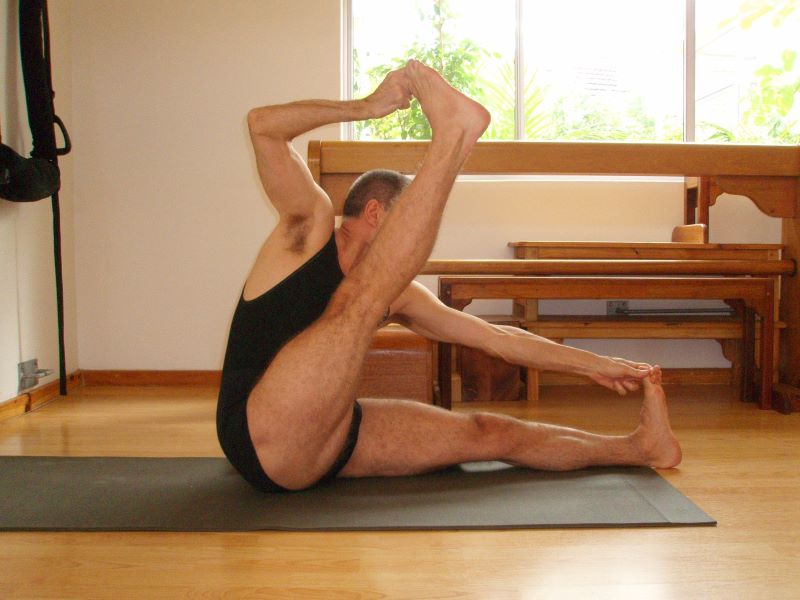
Sit with your legs stretched. With your right hand, hold the toe of your right leg. Raise your left leg upwards and hold the toes with your left hand. Your left elbow will be bent, but your left knee must be straight.
2. Twisted Akarna Dhanurasana
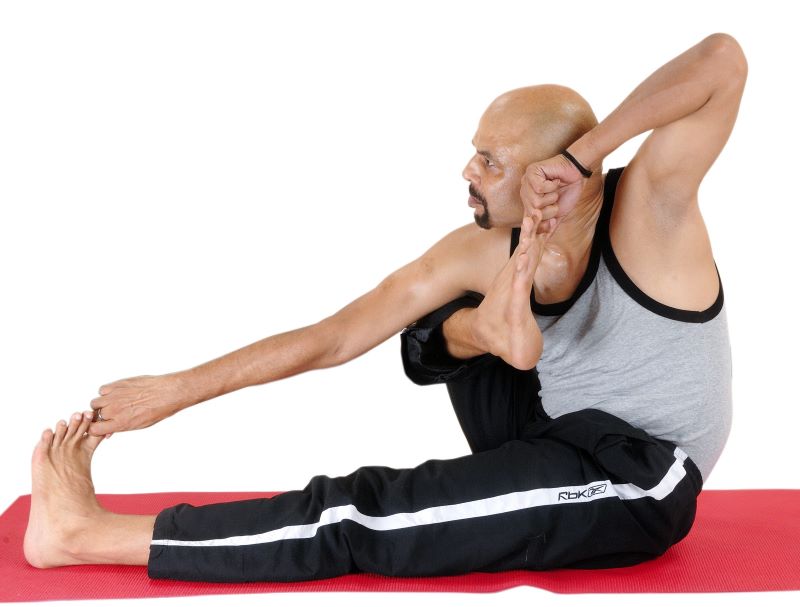
Sit with your legs extended. Bend your left knee, hold the toe with the right hand and bring it close to the right ear. Hold the right leg toe with the left hand. This right leg will be extended straight, strengthening the back.
These variations of Akarna Dhanurasana help to improve flexibility, strength, and spinal mobility while providing a deep stretch to the hips, thighs, and back muscles.
Things to Know Before Doing Akarna Dhanurasana
Akarna Dhanurasana requires some prep before attempting it. Here are some key points to know before doing Akarna Dhanurasana:
- Warm-Up: It's essential to warm up the body before attempting Akarna Dhanurasana. Engage in gentle stretching exercises or a short yoga sequence to prepare the muscles, joints, and spine for the deeper stretches and movements involved in the pose.
- Consult a Doctor: If you have any pre-existing medical conditions or injuries, it's advisable to consult with a healthcare professional before practising Akarna Dhanurasana. They can guide you on whether the pose is safe or recommend modifications to prevent exacerbating issues.
- Build Foundation: Before attempting the full expression of Akarna Dhanurasana, ensure that you have a strong foundation in basic yoga poses such as Uttanasana (Standing Forward Bend), Dhanurasana (Bow Pose), and other hip-opening and back-strengthening asanas.
- Proper Alignment: To prevent strain or injury, pay close attention to correct alignment when performing Akarna Dhanurasana. Keep the spine lengthened and shoulders relaxed, and engage the core muscles to support the backbend and twist.
- Listen to Your Body: Honour your body's limitations and listen to the signals it provides during the practice. If you experience pain, discomfort, or dizziness, immediately leave the pose and rest. Avoid pushing yourself too hard and gradually progress at your own pace.
- Use Props: If needed, use props such as yoga blocks or straps to support your practice. Props can help modify the pose to accommodate different levels of flexibility and make it more accessible while maintaining proper alignment.
- Breathing Awareness: Focus on steady and mindful breathing throughout the pose. Deep, rhythmic breathing can help calm the mind, enhance concentration, and facilitate a deeper stretch while preventing unnecessary tension or strain in the body.
- Exit Safely: When releasing from Akarna Dhanurasana, do so slowly and mindfully to avoid sudden movements or strain on the muscles and joints. Gently release the leg and return to a neutral position before transitioning to the next pose or resting in Savasana (Corpse Pose).
How Long to Sit in Akarna Dhanurasana?
Akarna Dhanurasana is a complex yoga pose. Here's a guideline for how long to sit in Akarna Dhanurasana based on different levels of practice:
- Beginners: Beginners should start with shorter durations to gradually build strength, flexibility, and endurance. A good starting point is holding Akarna Dhanurasana for 15-30 seconds on each side.
- Intermediate Level Practitioners: Intermediate practitioners with strength and flexibility can aim to hold Akarna Dhanurasana for 30-60 seconds on each side.
- Advanced Level Practitioners: Advanced practitioners who have mastered the basics of Akarna Dhanurasana can hold the pose for 60 seconds or more on each side, gradually working up to 90 seconds or even 2 minutes for a more intense challenge.
With practice, it is possible to master any yoga pose. However, even advanced practitioners should listen to their bodies and avoid pushing beyond their limits to prevent injury.
Risks of Overdoing Akarna Dhanurasana
Although there are many benefits to performing Akarna Dhanurasana, you should still practise caution. Here are the risks of overdoing Akarna Dhanurasana explained in points:
- Muscle Strain: Overdoing Akarna Dhanurasana can cause muscle strain, particularly in the back, hips, and thighs, as the pose involves intense stretching and twisting.
- Joint Pain: Overstretching the joints, especially the knees and hips, can cause pain and discomfort and exacerbate existing joint issues.
- Spinal Injuries: Performing Akarna Dhanurasana excessively or with improper alignment can increase the risk of spinal injuries, including herniated discs, compression fractures, or nerve impingement.
- Hip Flexor Tightness: Overdoing this pose can lead to tightness and strain in the hip flexors, which can affect mobility and flexibility in the hips.
- Compression of Abdominal Organs: Excessive compression of the abdominal organs in Akarna Dhanurasana can disrupt digestion and circulation.
- Risk of Falls and Injuries: Overdoing Akarna Dhanurasana without proper supervision or guidance can increase the risk of falls and injuries.
- Fatigue and Overexertion: Excessive performance of Akarna Dhanurasana without allowing the body proper rest and recovery can lead to fatigue and overexertion.
It's crucial to listen to your body's signals, practise moderation, and seek guidance from a qualified yoga instructor to avoid these risks and ensure a safe and beneficial practice.
4 Tips for Practising the Archer's Pose
As you now know about the procedure of Akarna Dhanurasana yoga, it will help if you know some tips. Below mentioned are some of the easy tips to achieve the right posture:
To begin with, always make sure that you go through a proper warm-up session to avoid any muscle strain.
Like any other exercise, you must synchronise your breath and movements while doing this yoga.
Start with the preparatory poses if you find the Archer's Pose difficult.
You can also practise more accessible versions of the same exercise prior to trying the advanced asana.
What are the Precautions and Contraindications of Archer's Pose?
Although there are several pros of Akarna Dhanurasana, you must follow certain precautions. This is because this yoga is highly advanced and requires extreme body flexibility. Here is a list of precautions and contraindications which you should keep a note of, especially if you are a beginner:
Individuals suffering from any kind of back injury, slipped disc, or spinal injury should avoid the Archer's Pose.
If you are pregnant, you must consult your doctor to know whether it is safe.
Those who have a weaker waist should refrain from doing this exercise.
Who Should Avoid Doing Akarna Dhanurasana?
To avail yourself of the complete benefit of Akarna Dhanurasana, it's essential to do it every day correctly. Here are some points on who should avoid doing Akarna Dhanurasana:
- Pregnant Women: Pregnant women should avoid this pose as it involves intense stretching and twisting, which may strain the abdomen and potentially harm the foetus.
- Individuals with Lower Back Issues: Those with lower back problems, such as herniated discs, sciatica, or chronic lower back pain, should avoid this pose, as the deep backbend and twisting involved can exacerbate their condition.
- Recent Abdominal Surgery: People who have undergone recent abdominal surgery, such as hernia repair or any other abdominal operation, should avoid this pose as it can strain the abdominal muscles and disrupt the healing process.
- Severe Knee or Hip Injuries: Individuals with severe knee or hip injuries should avoid this pose. It requires bending the knee and bringing the foot close to the ear, which can aggravate the injury and cause further discomfort.
- High Blood Pressure or Heart Conditions: Those with high blood pressure or heart conditions should avoid this pose as it involves intense stretching and compression, which can raise blood pressure and strain the heart.
- Vertigo or Balance Issues: Individuals who experience vertigo or have balance issues should avoid this pose as it requires maintaining balance on one leg while performing the pose, which can increase the risk of falls and injuries.
- Beginners without Proper Guidance: Beginners without proper instruction or guidance on performing Akarna Dhanurasana should avoid attempting it, as improper execution can lead to strain or injury in various parts of the body.
What are the Easy Modifications of Archer's Pose?
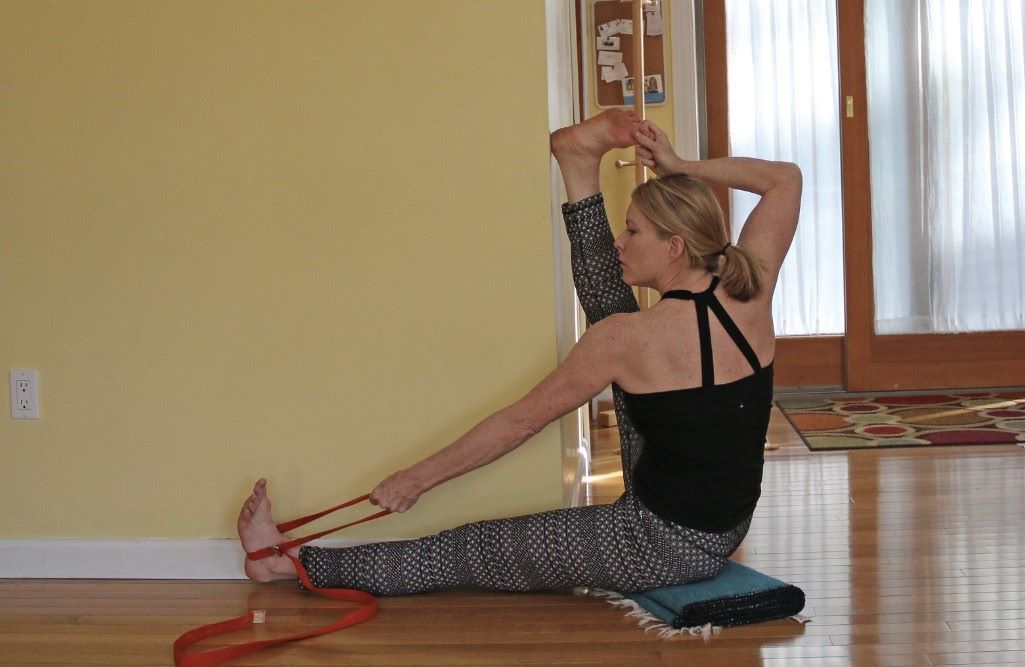
If you are tempted by the health benefits but find the posture extremely challenging, you can modify it slightly. In this way, you minutely make your way towards doing the actual posture:
- Use a Chair: Take a chair to rest your feet as you pull it towards your ear.
- Get a Yoga Strap: Those who cannot grab their feet can use a yoga strap.
- Use a Pillar for Support: When it is hard to balance, perform this yoga beside a pillar to rest your heel.
To conclude, Akarna Dhanurasana got its name from the posture it forms, which is similar to an archer. Moreover, this exercise is not easy to perform; you need to know basic yoga postures to reach this asana ultimately. If you find this posture fascinating, start with some preparatory poses to relax your muscles. Otherwise, you may get hurt or suffer a muscle pull.













